Efficient debt collection for energy suppliers: Riverty – keeping your finances in flow
Learn moreReducing operational costs with accounting automation
Learn moreIt is the kickoff to the holiday shopping season. Now is a good time to look back on previous editions and explore what Peak Season 2023 has in stock for e-commerce.

In this edition provides a comprehensive view of the intricacies of consumer behavior and e-commerce dynamics, as we reflect on past Peak Season successes and anticipate the challenges and opportunities that lie ahead for the busiest shopping time of the year.
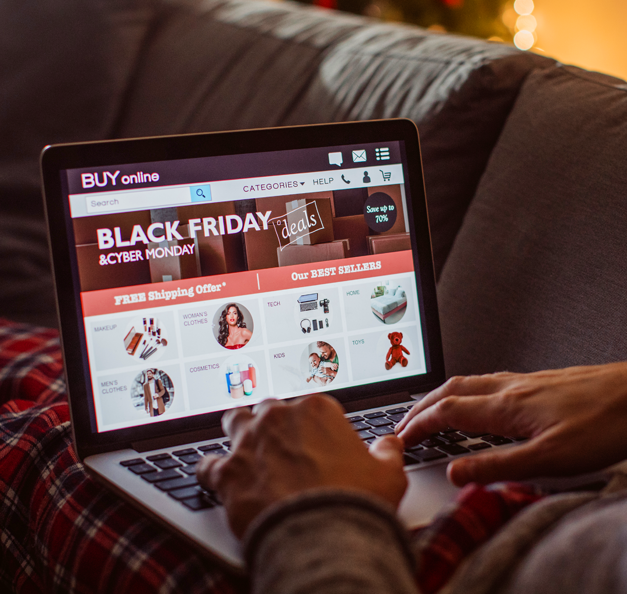
Traditionally, Black Friday marks the beginning of the holiday shopping season with significant discounts and promotions offered by retailers. While it was not a Dutch nor German tradition, retailers in the Netherlands and Germany participate in Black Friday sales events to attract shoppers and boost sales in the last quarter of the year.
Black Friday's growth in the Netherlands and Germany happens due to various factors, including consumer demand, the influence of online shopping trends, and the marketing efforts of retailers.
The super shopping holiday sales event gains popularity in both the Netherlands and Germany. Black Friday had already become a significant shopping event in 2022 with high awareness in both countries. While the sales event is not as deeply ingrained in Dutch and German culture as in some other countries (for instance the US and UK), it is becoming more visible and popular among consumers, as many Dutch and German retailers, both online and brick-and-mortar stores, actively participate in Black Friday promotions. Consumers are getting accustomed to seeking out deals and discounts on this day, and it is seen as an important kickoff to the holiday shopping season.
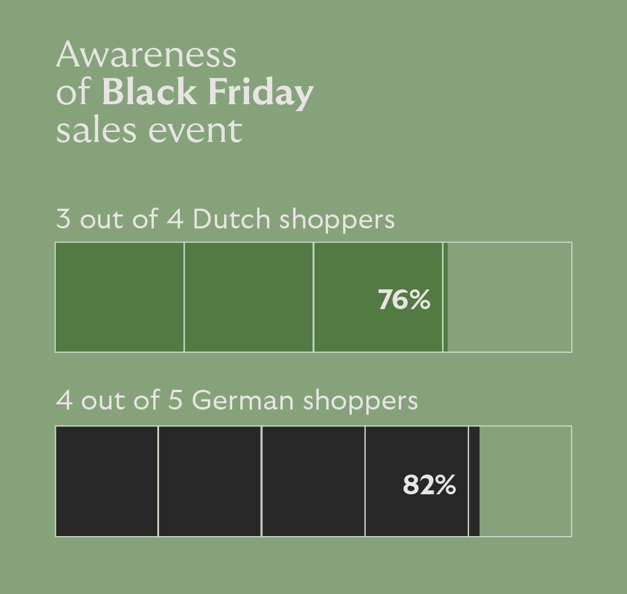
The awareness for this post-Thanksgiving shopping day is high. Over the years the holiday only sees increases in awareness. In 2021 the awareness was 63% for the Netherlands and 73% in Germany, following 2022 the numbers already amp up to 76% and 82% respectively. Expectations are for 2023s Peak season that the awareness will be a little bit higher that the 77% Dutch and 83% share, as it is already the vast majority of the consumers. The sales event has no origin the European nations, and thus will assumably not hit the full 100% in awareness. It is reasonable to predict that the high awareness reflects in growth in purchase intent in Peak 2023.
The increase of awareness will depend on the marketing campaigns brands and companies launch this season. The more advertisements and messaging go out and reached the consumers, the higher the awareness will be in 2023. The expectation is at least to see a similar attractiveness to buy compared to the previous year, as it is difficult to predict the actual purchase intent.
Black Friday is rated as sales event with the Best Deal and annually invites consumers back to shop for more. The loyalty for this event is therefore very high (73% in the Netherlands and 71% in Germany) and will only grow to be more loyal in the coming years.
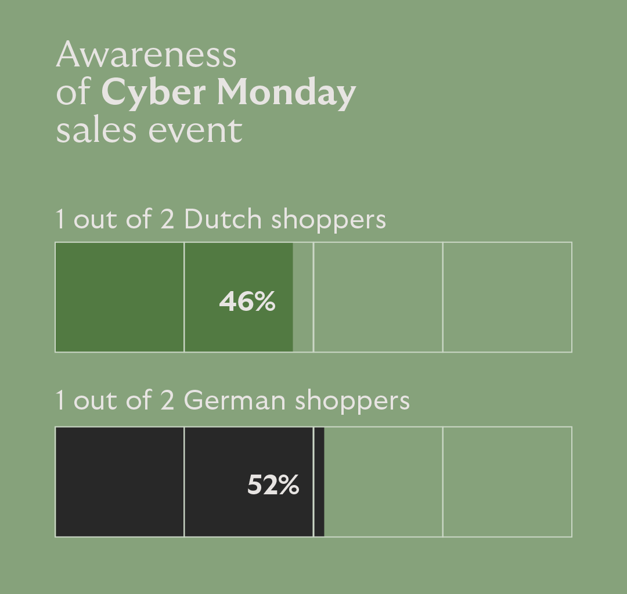
1 in 2 German consumers (52% in 2022 vs 40% in 2021) say they are informed about the day, followed by both the Dutch and with a 46% share of Cyber Monday awareness (vs 33% in 2021 respectively). Just like Black Friday, the numbers will likely again go up this year for both awareness and getting ahead with making purchases on Cyber Monday.
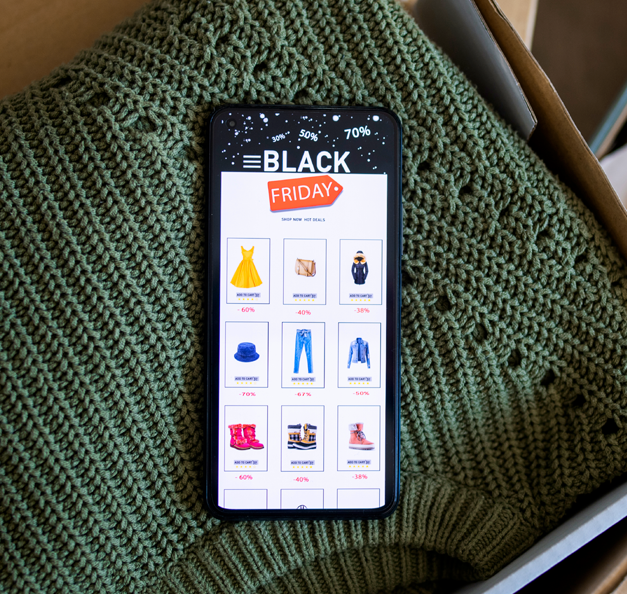
It is only the beginning of the last quarter of the year. Already almost 1 out of 3 online shoppers are now actively looking for a Buy Now Pay Later solution in checkout. This current number is higher compared to previous Peak Season in Q4 of 2022. The share of BNPL-solution seekers is growing from 25% to 28%, and is likely to increase more throughout the last months of 2023.
Riverty is signaling a shift in consumer payment needs and behavior. As we enter the final quarter of 2023, the data shows that nearly 1 in 3 online shoppers are actively seeking BNPL options during checkout, exceeding the statistics from the previous year's Q4 peak season. The percentage of shoppers seeking BNPL has risen from 25% to 28%, and this trend is expected to continue grow in the coming months. This not only underlines the increasing popularity of BNPL but also suggests that they are likely to play an even more prominent role in the future of e-commerce.
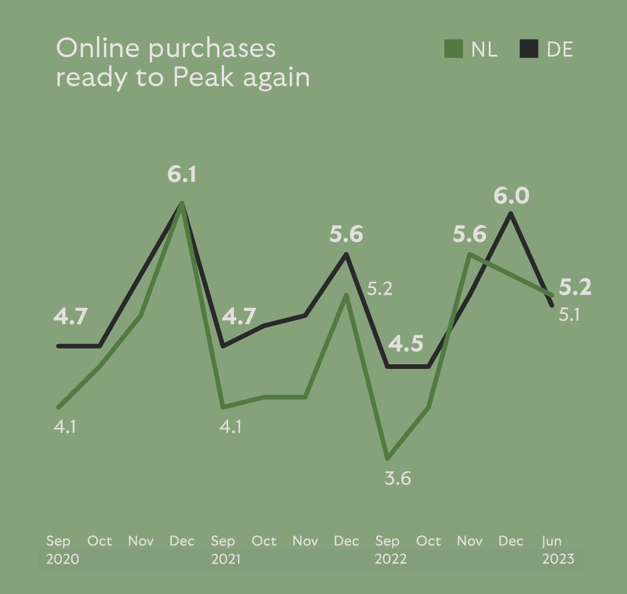
The highest volume known in the Riverty database for Peak Season is from December 2020. The obvious reason being the lockdown during the pandemic, causing for the shift from offline-to-online holiday (gift) shopping. Both Dutch and German online volumes hit the 6.1. the two following years still have an upward trend in online volumes in Peak from September to December. The volume in December 2021 strikes up the lower 5.2 in the Netherlands and 5.4 in Germany, while 2022’s volumes increase again to 5.4 and 6 respectively.
The last measure of online volumes in June 2023 marks already 5.2 in the Dutch region and 5.1 in Germany. These numbers are both higher than all the Peak-starting points in the September months of the previous years (all ranging from 3.6 to 4.7). This is good news and a positive outlook for all retailers and online shops, as consumers are willing to spend their money. The Peak Season is likely to benefit from that, too, and the big sales events have not even passed us yet.
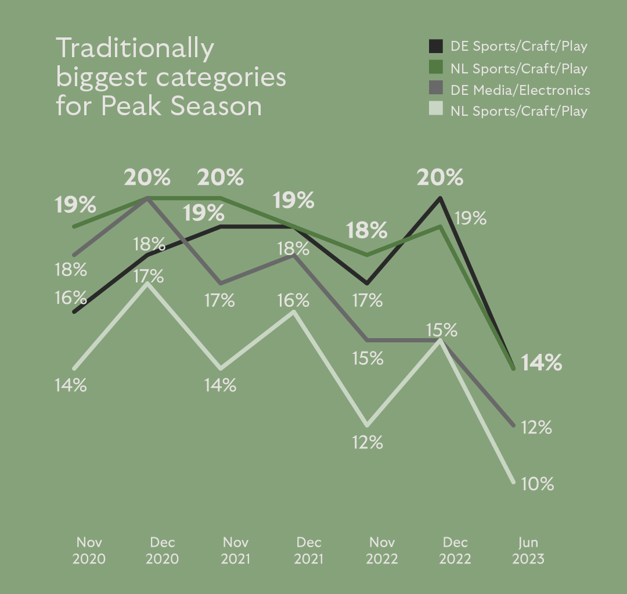
Sports/Craft/Play and Media/Electronics are expected to see an uplift again for this Peak Season. Traditionally these verticals always have a higher share in the final months of the year since they hold the Toys categories and Electronics, which are typical holiday presents. The tables show the shares for November and December over the past years, as well as the latest measurement in June. The shares in June are comparable to the average of the category throughout the year.
Fashion and Cosmetics, and Health/Food Products accumulate the biggest shares again this Peak Season. These categories are always the biggest, no matter the time of year.
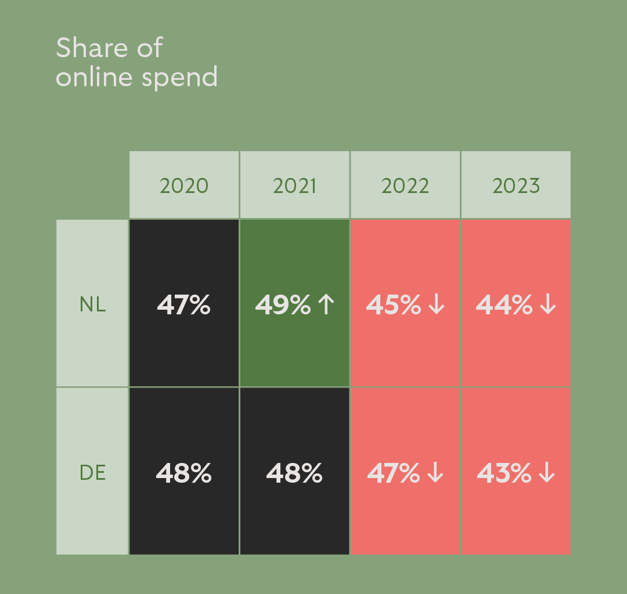
The annual pattern of online and offline spend continues well into 2023. The fluctuations are visible in both countries with the seasonal changes. Of course, all Peak Seasons see the climb, with the highest point always in December, followed by a big dip in January. Over time, the share of online spend is fairly stable, with the slightest downward trend. As a comparison, the December 2020 online share hit 48% for both Germany and the Netherlands, December 2021 apex is 49% (NL) and 48% (DE), while the last month of 2022 dips to 45% (NL) and 47% (DE). The last shares from June 2023 attains 44% (NL) and 43% (DE). It is guaranteed that the December share of online shopping vs offline will increase again to a higher percentage, to dip down again in January.
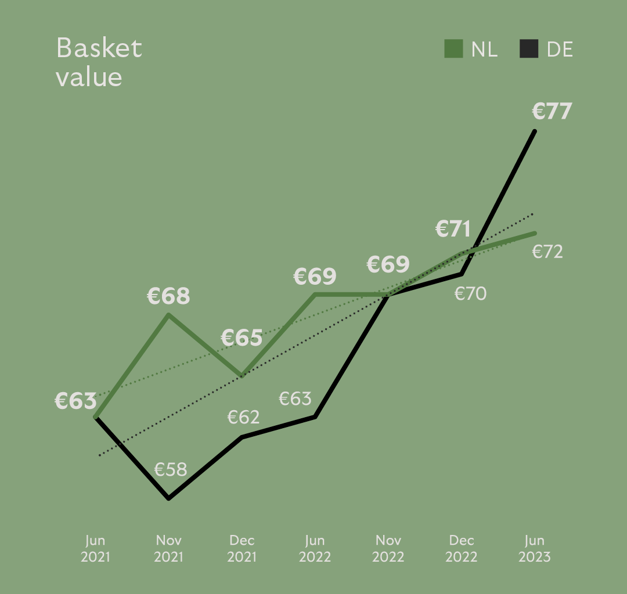
The basket value, however, is showing a different trend. Reflecting on all previous moments of measure, the basket value per month is seeing a steady but slow increase. The differences in trends are related to each other: if the volume is going down, the basket value goes up automatically. The phenomenon is easily explained by the way consumers shop: they either place many different orders (driving up the volume, lowering the value) or they buy more things in one checkout (driving up the basket value, lowering the volume).
In previous Peak Seasons the basket values are not always the highest of the (whole) year, however, there is always a visible increase from September till December. 2022 topped 2021 in both the Netherlands (November ‘22 €69, December ’22 €71 vs November ‘21 €68, December ’21 €65) and Germany (November ‘22 €69, December ’22 €70 vs November ‘21 €59, December ’21 €62). The latest June measurements of basket value are even higher (Netherlands €72 and Germany €77).
Since the general trend is an upward development and June already sees a climbing basket value, the expectations for this Peak Season are that the 2023 November and December months are going to top last year’s.
Financial worries are declining and are much lower compared to last year. Other trends in Germany and the Netherlands have shifted only a little bit compared to last year.
The biggest difference is visible in the worry about the economy, which can be explained by the decrease of inflation and gas prices. On the contrary, another difference is noticeable in the slightly increasing share of safety concerns. Both Dutch and German consumer currently say they are really concerned that their society is becoming less safe, more so compared to last December 2022. Reason being the national drug wars, the international political clashes, such as China and Taiwan, North Korea meeting with Russia, the ongoing Ukraine war and the NATO expansion. Interesting to note is how easily scared society gets by threats, and on the contrary, how easily society gets used to these threats, which is evident by the dramatic rise and drop in numbers.
The trend on taking care of the environment in the form of consumption reduction and choosing for quality over quantity remains important in the two nations. The German shares of the willingness to only buy products that I really need, and choose quality over quantity, as well as consciously buying less to reduce consumption continue to be high(er), while the Dutch are slowly garnering more interest in consciously buying less to reduce their consumption. What is interesting is the growth in desire to be sustainable, while still 1 in 3 Dutch (31%) shoppers and 1 out of 5 German (22%) shoppers choose an affordable product over a sustainable product.
In the Netherlands and Germany.
As previously mentioned, the financial worry is much lower compared to the previous year. The inflation kept minds occupied at the start of Peak Season in September 2022. The rising prices of groceries and other necessities of life drove the levels of financial worries to 42% in the Netherlands and 55% in Germany. Like many other things, people get used to situations and no longer see the high urgency on those matters. This truly show at the end of the year (December 2022) the inflation was on its way down, seeing a similar trend in worry levels (Financial worry December 2022: NL 27% / DE 40%). The current inflation is still scaling off and that shows in a constant level of worries (Financial worry June 2023: NL 27% / DE 41%).
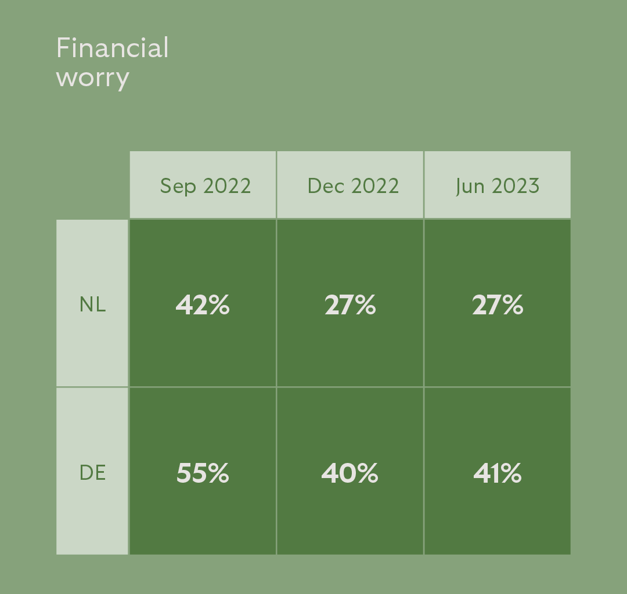
Also read our other Riverty ecommerce Review content pieces to learn more about online shopping, consumer needs, payment desires, fintech trends and much more.